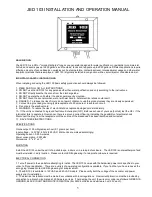
12
100158
ENGLISH
OPERATION
While charging a device do not place on the exhaust side
of the generator. Extreme heat caused by exhaust can
damage the device, and cause a potential fire hazard.
WARNING
12V DC Outlet Cont’d.
12V DC Outlet – Battery Charging
1. Before connecting the battery charging cable to a
battery that is installed in a vehicle, disconnect the
vehicle battery ground cable from the negative (–)
battery terminal.
2. Plug the battery charging cable into the 12V DC
receptacle of the generator.
3. Connect the red (+) battery charger lead to the red
(+) battery terminal.
4. Connect the black (–) battery charger lead to the
black (–) battery terminal.
5. Start the generator.
Important: The 12V DC outlet is ONLY to be used with
the supplied 12V DC battery charging cable. The 12V
DC output is unregulated and will damage other 12V
DC products. When using the 12V DC outlet, turn the
Economy mode switch to the “OFF” position. Be sure all
electric devices including the lines and plug connections
are in good condition before connection to the generator.
Be sure all electric devices including the lines and plug
connections are in good condition before connection to
the generator.
NOTE
Do not start the vehicle while the battery charging cable is
connected and the generator is running. It will not give the
battery a boost of power. The vehicle or the generator may
be damaged. Charge only vented wet lead acid batteries.
Other types of batteries may burst, causing personal injury
or damage.
CAUTION
Stopping the Engine
1. Turn off and unplug all electrical loads. Never start
or stop the generator with electrical devices plugged
in or turned on.
2. Let the generator run at no-load for several minutes
to stabilize internal temperatures of the engine and
generator.
If the engine will not be used for a period of two (2)
weeks or longer, please see the storage section for
proper engine and fuel storage.
NOTE
3. Turn the fuel valve to the “OFF” position.
4. Let the engine run until fuel starvation has stopped
the engine. This usually takes a few minutes.
5. Turn the engine switch to the “OFF” position.
Important: Always ensure that the fuel valve and the
engine switch are in the “OFF” position when the engine
is not in use.
Stopping the Engine Cont’d.
Do Not Overload Generator
Capacity
Follow these simple steps to calculate the running and
starting watts necessary for your purposes.
1. Select the electrical devices you plan on running at
the same time.
2. Total the running watts of these items. This is
the amount of power you need to keep your items
running.
3. Identify the highest starting wattage of all devices
identified in step 1. Add this number to the number
calculated in step 2. Surge wattage is the extra
burst of power needed to start some electric driven
equipment. Following the steps listed under “Power
Management” will guarantee that only one device
will be starting at a time.
Power Management
Use the following formula to convert voltage and
amperage to watts:
Volts x Amps = Watts
To prolong the life of your generator and attached
devices, follow these steps to add electrical load:
1. Start the generator with no electrical load attached.
2. Allow the engine to run for several minutes to
stabilize.
3. Plug in and turn on the first item. It is best to
attach the item with the largest load first.
4. Allow the engine to stabilize.
5. Plug in and turn on the next item.
6. Allow the engine to stabilize.
7. Repeat steps 5-6 for each additional item.
















































